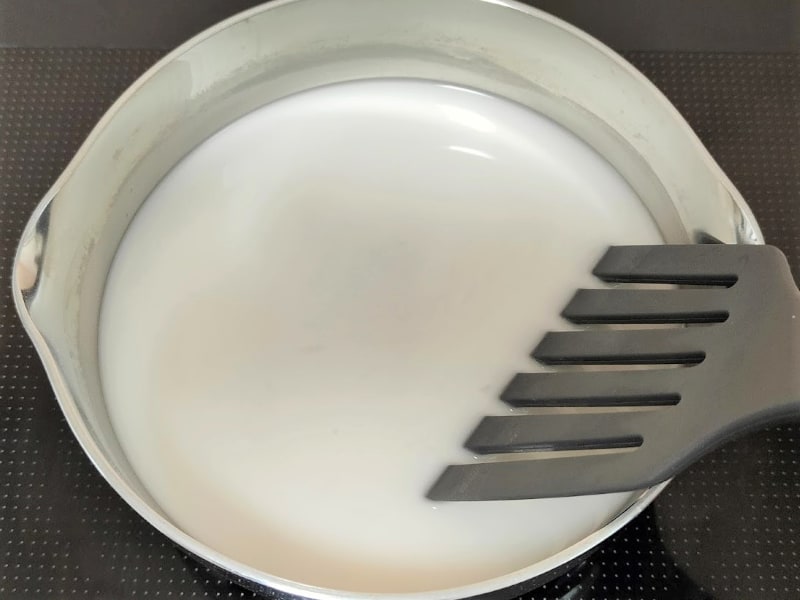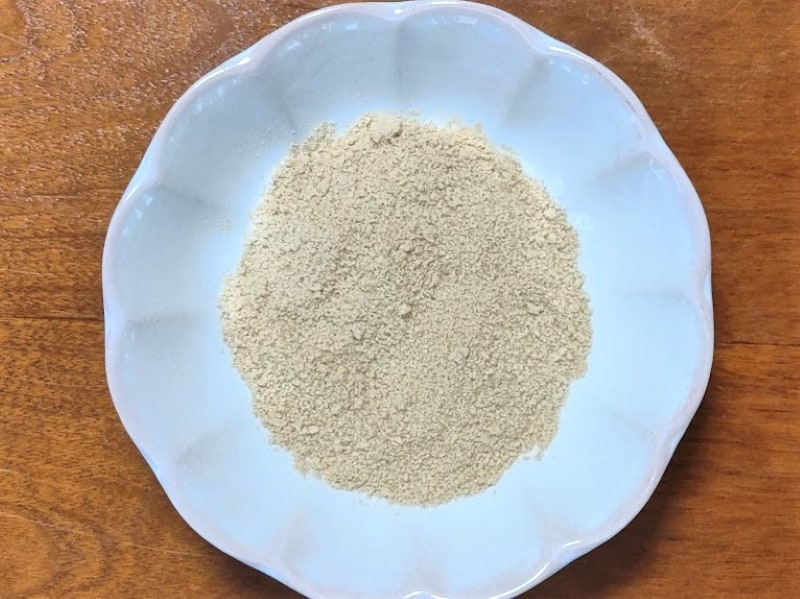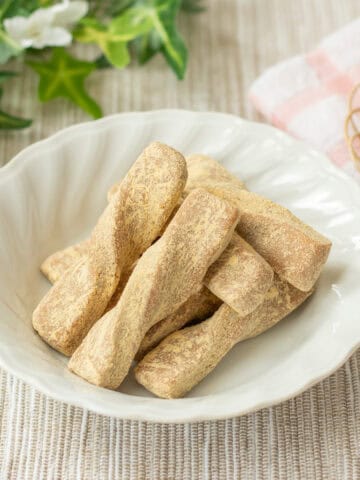Slightly sweet with a soft, chewy, jelly-like texture, Warabi Mochi is a traditional Japanese sweet. Once you have gathered the ingredients, it is easy to make with a simple process.

Jump to:
What is Warabi Mochi?
Warabi Mochi is a traditional Japanese sweet made by heating a mixture of bracken starch (known as warabiko or warabi mochiko) and sugar dissolved in water. "Warabi" means bracken fern, and "Mochi" refers to Japanese rice cakes.
Although this sweet doesn't contain mochi or mochi ingredients, it is called warabi mochi because its texture is similar to that of mochi. It is commonly served with kinako (roasted soybean flour) and kuromitsu (brown sugar syrup).
The history of this sweet dates back over a thousand years. While the ingredients may have been slightly different in the past, the preparation method and taste have remained largely unchanged. It can be enjoyed year-round, but in Japan, it is particularly popular during the hot summer months due to its refreshing nature.
Differences between warabiko and warabi mochiko
Simply put, 'warabi mochi' comes in variations with a dark, translucent appearance and a colorless, transparent one. These differences stem from the choice of ingredients, specifically whether one uses 'warabiko' or 'warabi mochiko.'
'Warabiko' refers to starch extracted solely from the roots of the bracken fern. On the other hand, 'warabi mochiko' includes starches from other ingredients such as kudzu, potatoes, sweet potatoes, and tapioca, in addition to bracken fern. When dissolved in water, 'warabiko' turns dark, while 'warabi mochiko' turns white.
'Warabiko' is quite rare and challenging to find. Even if you come across a product labeled as 'warabiko,' be aware that it might actually be 'warabi mochiko' containing other starches. When making a purchase, it is advisable to carefully check the ingredient list.
Exploring traditional warabi mochi
Originally, warabi mochi was made with 'warabiko.' However, as the production of warabiko decreased over time, around 400 years ago, kudzu starch started to be mixed in. In modern times, other starches have also been added. Therefore, it is now common to use 'warabi mochiko,' a mixed starch that includes bracken starch, when making warabi mochi.
Traditional warabi mochi, made using 'warabiko,' is still enjoyed today and is also known as "Hon Warabi Mochi" (authentic warabi mochi). It has a dark color and a chewy texture. It is so soft that picking it up with chopsticks can be challenging, and it melts smoothly in your mouth. If you ever have the opportunity to obtain 'warabiko,' I highly recommend trying to make "Hon Warabi Mochi."
Alternative for bracken starch
Bracken starch (warabiko or warabi mochiko) should be available at Asian markets, but if it is not, you can also substitute it with potato starch. The texture might be slightly different, but you should still be able to enjoy a treat that resembles warabi mochi.
Ingredients
- 1.8 oz warabi mochiko or warabiko (bracken starch)
- 2 Tbsp sugar
- 1 ¼ cups water
Toppings:
- 1 Tbsp kinako (roasted soybean flour)
- 2 tsp sugar (not used when eating with kuromitsu)
- 2 Tbsp kuromitsu (brown sugar syrup) (optional)
Step-by-step instructions
🕒 Total 40 mins

Step 1
Combine warabi mochiko, sugar, and water in a pot.

Step 2
Heat the pot over medium heat and stir the mixture constantly with a spatula until it starts to thicken.

Step 3
Reduce the heat to low and keep stirring until the mixture gradually solidifies and turns transparent. Continue stirring for a few more minutes after it becomes clear, then turn off the heat.

Step 4
Transfer the mixture to a sheet pan and let it cool for at least 10 minutes. After that, place the pan in the refrigerator and chill for 20 minutes.

Step 5 (optional)
Mix kinako and sugar together. (If you are using kuromitsu as a topping, skip this step, as it will make the warabi mochi too sweet.)

Step 6
Remove the pan from the refrigerator and sprinkle the kinako mixture (or just kinako) over the warabi mochi. Then, cut it into bite-sized pieces.

Step 7
Serve the pieces on plates and top with kuromitsu to taste.
To Store
You can store it in the refrigerator for up to 2 days. However, it is recommended to consume it as soon as possible because its texture may deteriorate over time. Freezing is not recommended.
Additionally, if you are using 'warabiko' instead of 'warabi mochiko,' please note that it doesn't have a long shelf life. It should be stored at room temperature and consumed on the same day.
Tips on how to make
- Avoid refrigerating warabi mochi for an extended period in step 4. It tends to harden when chilled for too long.
- Kinako should be applied just before eating. If you store warabi mochi with kinako already sprinkled on it, the kinako will absorb moisture and compromise the texture of the warabi mochi.
Matcha flavor variations
In Japan, it is also popular to enjoy warabi mochi with matcha flavor. By simply adding matcha powder, you can create matcha-flavored warabi mochi. If you want to make it, add 1 tsp of matcha powder for every 2 servings in step 1. There is no need to change the amounts of the other ingredients.
Additionally, you can make matcha-flavored kinako (roasted soybean flour) by mixing 1 tsp of matcha powder into the kinako for every 2 servings in step 5. Feel free to try it according to your preference.

Recipe Card

Warabi Mochi
Ingredients
- 1.8 oz warabi mochiko or warabiko (bracken starch)
- 2 Tbsp sugar
- 1 ¼ cups water
Toppings:
- 1 Tbsp kinako (roasted soybean flour)
- 2 tsp sugar (not used when eating with kuromitsu)
- 2 Tbsp kuromitsu (brown sugar syrup) (optional)
Instructions
- Combine warabi mochiko, sugar, and water in a pot.
- Heat the pot over medium heat and stir the mixture constantly with a spatula until it starts to thicken.
- Reduce the heat to low and keep stirring until the mixture gradually solidifies and turns transparent. Continue stirring for a few more minutes after it becomes clear, then turn off the heat.
- Transfer the mixture to a sheet pan and let it cool for at least 10 minutes. After that, place the pan in the refrigerator and chill for 20 minutes.
- (Optional) Mix kinako and sugar together. (If you are using kuromitsu as a topping, skip this step, as it will make the warabi mochi too sweet.)
- Remove the pan from the refrigerator and sprinkle the kinako mixture (or just kinako) over the warabi mochi. Then, cut it into bite-sized pieces.
- Serve the pieces on plates and top with kuromitsu to taste.
Notes
- You can store it in the refrigerator for up to 2 days. However, it is recommended to consume it as soon as possible because its texture may deteriorate over time. Freezing is not recommended.
- If you are using 'warabiko' instead of 'warabi mochiko,' please note that it doesn't have a long shelf life. It should be stored at room temperature and consumed on the same day.
- If you want to make matcha-flavored warabi mochi, add 1 tsp of matcha powder for every 2 servings in step 1.
- For matcha-flavored kinako, mix 1 tsp of matcha powder into the kinako for every 2 servings in step 5.





Leave a Reply